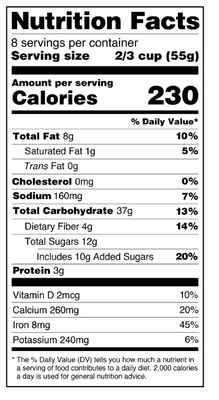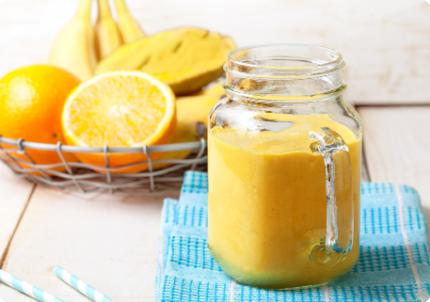Questions and Answers About Vitamin D (FN2008, February 2021)
Q: What is vitamin D?
Vitamin D is a fat-soluble vitamin that is important for many functions in the body. This nutrient helps us absorb calcium to build and maintain strong bones throughout life. Muscles need vitamin D to move, and nerves need it to carry messages between the brain and body systems. Researchers have linked vitamin D to roles in maintaining heart health and immune function. Vitamin D may play a role preventing cancer, diabetes and other chronic diseases. Too little vitamin D may play a role in depression and other mental illnesses.
Q: How much vitamin D do I need?
The amount of vitamin D you need depends on your age and other factors. The table below shows the recommended dietary allowances (RDA) for vitamin D.
|
Age |
Male |
Female |
Pregnancy |
Lactation |
|
0-12 months* |
10 mcg |
10 mcg |
||
|
1–13 years |
15 mcg |
15 mcg |
||
|
14–18 years |
15 mcg |
15 mcg |
15 mcg |
15 mcg |
|
19–50 years |
15 mcg |
15 mcg |
15 mcg |
15 mcg |
|
51–70 years |
15 mcg |
15 mcg |
||
|
>70 years |
20 mcg |
20 mcg |
Key to abbreviations: mcg = micrograms; IU = international units
*Follow the guidance from your health-care provider for infants and throughout life.
Q: What foods provide vitamin D?
Very few foods contain vitamin D. Some foods, such as milk, are fortified with vitamin D. Fortified means that vitamin D was added to the food product. Cereal and orange juice often are fortified with vitamin D. Vitamin D is found naturally in fatty fish such as salmon, tuna and mackerel. Vitamin D is found in small amounts in cheese and egg yolks.
This table shows foods that are good sources of vitamin D as well as some foods that are not good sources of vitamin D. Even though whole grains, fruits and vegetables do not contain any vitamin D, they do contain nutrients that the body needs.
|
Food |
Portion Size |
Micrograms per serving |
Percent (%) Daily Value |
|
Cod liver oil |
1 tablespoon |
34 |
170 |
|
Salmon (sockeye) |
3 ounces |
14.2 |
71 |
|
Vitamin D-fortified milk |
1 cup |
2.9 |
15 |
|
Ready-to-eat cereal |
1 cup |
2.0 |
10 |
|
Sardines |
2 sardines |
1.2 |
6 |
|
Egg |
1 large |
1.1 |
6 |
|
Beef liver |
3 ounces |
1.0 |
5 |
|
Tuna fish, canned in water |
3 ounces |
1.0 |
5 |
|
Cheddar cheese |
1 ounce |
0.3 |
2 |
|
Chicken breast |
3 ounces |
0.1 |
1 |
|
Mushrooms |
½ cup |
0.1 |
1 |
|
Apple |
1 whole |
0 |
0 |
|
Whole-wheat bread |
1 slice |
0 |
0 |
|
Almonds |
1 ounce |
0 |
0 |
Source of information: https://ods.od.nih.gov/factsheets/VitaminD-HealthProfessional
The Nutrition Facts labels found on most foods show the amount of vitamin D per serving.

Q: Does the sun provide vitamin D?
The body can make vitamin D when skin is directly exposed to the sun. Getting sun through a car window will reduce the amount of vitamin D made. People with dark-colored skin also will not make as much vitamin D. However, avoid becoming sunburned; wear sunscreen and take other precautions, especially if you work or play in the sun.
Q: Can I get too much vitamin D?
Getting too much vitamin D is possible but not likely. The upper limit of vitamin D is 100 micrograms (4,000 IU) for adults. Many people do not get the recommended 15 micrograms per day, so the possibility of getting too much is highly unlikely. If you do get too much vitamin D, that can lead to a toxicity and cause a number of issues including nausea, vomiting and weakness.
Q: Should I be taking a vitamin D supplement?
People in the northern parts of the U.S. generally do not make enough vitamin D from sun exposure, especially during winter months. Consider the foods you eat. Consult your health-care provider and/or a registered dietitian to determine if you need a dietary supplement and how much you would need to take.
Vitamin D-rich Recipe Ideas
Main Dish Salad
Toss your favorite salad greens and sliced vegetables in a bowl. Top with sliced hard-cooked eggs (rich in vitamin D) and a grilled/broiled salmon filet (rich in vitamin D). Add favorite dressing. Serve with a glass of milk.

- This “breakfast on the go” is rich in potassium, and vitamins D and C. (iStock photo)
Orange Creamsicle Smoothie
1 medium frozen banana, previously peeled and sliced
2 tsp. pure vanilla extract
½ c. vitamin D fortified orange juice
¾ c. vitamin D fortified vanilla Greek low-fat yogurt
1 orange, peeled and sliced
Whirl all ingredients together in blender. Makes two servings.
Each serving has 190 calories, 1.5 grams (g) fat, 6 g protein, 41 g carbohydrate, 3 g fiber, 60 milligrams sodium and about 10% of the daily recommendation for vitamin D.
More Information
If you would like more information, please visit https://ods.od.nih.gov/factsheets/VitaminD-Consumer/.

